Until Russia’s invasion of Ukraine in 2014, the two countries maintained relations that at times were testy, but manageable. But following Moscow’s annexation of Crimea, writes Steven Pifer, attitudes within Ukraine toward Russia have hardened to a considerable degree, and the appeal of Western institutions such as the European Union and NATO has grown. This piece originally appeared in The Ambassadors Review, the foreign affairs journal of the Council of American Ambassadors.
Following the Soviet Union’s collapse, Ukraine and Russia maintained relations that at times were testy, but their differences largely appeared manageable. That changed in 2014, when the Kremlin used military force to seize Crimea and then supported armed separatism in the eastern Ukrainian region of Donbas. As a result, attitudes within Ukraine toward Russia have hardened to a considerable degree, and the appeal of Western institutions such as the European Union and NATO has grown.
A Testy Relationship with Russia
The end of the Soviet Union in 1991 left newly independent Ukraine with a number of difficult issues with Russia: (1) the fate of the Soviet nuclear weapons systems in Ukraine, (2) division of the Black Sea Fleet, (3) resolution of energy and other debts, and (4) Crimea, which had been transferred from the Russian Soviet Federative Socialist Republic to the Ukrainian Soviet Socialist Republic in 1954.
With U.S. help, Ukraine and Russia found agreement on the elimination of the nuclear weapons. Kyiv and Moscow separately struck an arrangement on dividing the ships of the Black Sea Fleet, and Ukraine agreed to allow Russia to use ports and other facilities in Crimea for its warships, an agreement that was later extended to 2047. The sides resolved their differences over debts and, while they had occasional spats over energy, particularly natural gas contracts, they usually found a solution.
As for Crimea, the only part of Ukraine with a majority population of ethnic Russians, tensions periodically arose. But the Russian government in the 1990s and 2000s generally respected the agreement reached among the newly independent states when the Soviet Union fell apart: those states would be recognized within their borders at the time, i.e., Crimea was a part of Ukraine.
Turns to Conflict
That changed in 2014. Following the Maidan Revolution and then-President Viktor Yanukovych’s flight from Kyiv (and Ukraine), Russian soldiers with identifying insignia stripped from their uniforms seized Crimea. Within three weeks, following a wholly sham referendum, Russia illegally annexed the peninsula.
Several weeks later, armed separatists took action in Donbas. They had full support from Russia, including leadership, funding, heavy weapons, ammunition and, at times, regular units of the Russian army. Indeed, the fighting in Donbas is more correctly described as a conflict between Ukraine and Russia.
German Chancellor Angela Merkel and then-French President François Hollande brokered a settlement between Ukrainian President Petro Poroshenko and Russian President Vladimir Putin in February 2015 (an arrangement referred to as Minsk II). The initial provisions called for a ceasefire and withdrawal of heavy weapons from the line of contact, but those goals have never been achieved. Most observers lay the bulk of the blame on the Russians and separatist fighters. By all appearances, the Kremlin prefers to continue a simmering conflict in Donbas as a means to undermine and destabilize the government in Kyiv, in order to hinder its effort to build a successful Ukrainian state and implement its association agreement with the European Union.
Ukraine has found itself in conflict with Russia now for more than three years. While the seizure of Crimea was relatively bloodless, some 10,000 have died in eastern Ukraine, not counting an unknown number of Russian military personnel.
Attitudes Harden
One result of the ongoing conflict is hardening attitudes among the Ukrainian population toward Russia and Russians. When Ukraine first regained its independence in the early 1990s, some nationalists held sharply anti-Russian views, but they constituted a small minority. The large majority of Ukrainians generally hoped to get along with Russia; many spoke Russian as their first language and had family and/or friends in Russia.
Russia’s aggression changed that dramatically. Since 2014, a Ukrainian national identity has taken hold. It includes a strong anti-Russian animus. In an April 2017 public opinion survey conducted by Rating Group Ukraine, 57 percent of Ukrainians polled expressed a very cold or cold attitude toward Russia, as opposed to only 17 percent who expressed a very warm or warm attitude.
The hardening of anti-Russian sentiment could make it more difficult for Kyiv to implement the political provisions of Minsk II if a ceasefire were to take hold. For example, Poroshenko agreed in Minsk II to a constitutional amendment on decentralization of some political authorities. Two and a half years after the conclusion of Minsk II, and with no sustained ceasefire, many Ukrainians now regard decentralization as an unwarranted concession to the Russians and separatists. It is not clear that Poroshenko could secure a constitutional majority in the Rada (parliament) to pass such an amendment.
The Allure of the European Union
As anti-Russian sentiment has grown, so has the appeal of the West. The European Union, with its allure of economic prosperity and functioning democracy, has long attracted the interest of a sizeable portion of the Ukrainian population. That appeal grew as the Yanukovych presidency lurched toward greater authoritarianism in 2010-2013. It was the Yanukovych decision not to sign an association agreement with the European Union that triggered the first demonstrations in Kyiv in November 2013. Those grew into a broader protest against Yanukovych.
Following the Maidan Revolution and Yanukovych’s departure, the Rada appointed an acting president and an acting prime minister. They immediately made clear that their number-one foreign policy priority was to sign the EU association agreement, a priority that had wide public support. Poroshenko signed the association agreement on June 27, 2014, and it took full effect on September 1, 2017. Although EU leaders have refused thus far to give Ukraine a membership perspective, 53 percent of Ukrainians who were surveyed in April 2017 favored joining the European Union as opposed to any other international economic union.
Among other things, the agreement contains a deep and comprehensive free trade arrangement that will bolster Ukraine-EU trade. If Ukraine fully implements the association agreement, it will adopt many EU political and economic standards. While the agreement offers Ukraine no membership perspective, full implementation would bring Ukraine to a point where it should be considered.
The Ukrainian leadership and public have warmly embraced the idea of drawing closer to the European Union. A key question now is: can the government implement the association agreement? And will Kyiv find a way to persuade EU members that Ukraine merits consideration for membership, despite Moscow’s staunch opposition? That could prove a tough proposition, and it would be wise for the government in Kyiv to moderate public expectations about future EU membership.
Growing Support for NATO
Poroshenko in Spring 2014 indicated a readiness to set aside issues such as a membership action plan with NATO if that would help find a settlement with Moscow. But he has reversed that view. In July of this year, he said that Kyiv would pursue a membership action plan and expressed the hope that Ukraine could meet NATO’s membership criteria by 2020.
The last three years have also witnessed growing Ukrainian public support for joining NATO. For example, the April 2017 survey showed that 46 percent of Ukrainians favor joining the alliance, as opposed to 27 percent who opposed joining. This is a reverse of the results from a March 2014 survey, in which 43 percent opposed joining NATO while only 34 percent favored doing so. In the 1990s and 2000s, support for NATO membership rarely if ever broached 25 percent. The upswing almost certainly represents a backlash against Russia’s aggression.
There is little support within NATO for putting Ukraine on a membership track, and membership is not in the cards in the near term. Here, too, it would be wise for the government in Kyiv not to inflate public expectations. But Ukraine can do much with the alliance in terms of practical cooperation, including steps that would bring the country closer to NATO standards and values.
Views of the United States
While the European Union offers the close attraction, the Ukrainian government and many Ukrainians see the United States as Kyiv’s primary security partner. Some criticize Washington for not doing more after Moscow violated the 1994 Budapest Memorandum, in which the United States, Britain and Russia agreed to respect Ukraine’s sovereignty, territorial integrity and independence and not to use force against Ukraine. But Ukrainians recognize the weight carried by Washington in formulating a Western policy to support Ukraine as well as the fact that the U.S. government tends to take a more strategic view of Ukraine and its geopolitical situation than do most European countries.
The November 2016 U.S. presidential election startled many in Kyiv. They had followed Donald Trump’s candidacy, including his oft-stated desire to improve relations with Putin and his suggestions that the United States might drop sanctions on Russia and/or recognize Crimea’s illegal annexation.
Eight months into the Trump presidency, however, Ukraine has been reassured by actual U.S. policy. Senior administration officials have stated that the United States would not accept Crimea’s annexation, and Washington has maintained and even strengthened sanctions. (Congress, moreover, enacted legislation that gives it a say in any loosening of sanctions on Russia.) Secretary of State Rex Tillerson and Secretary of Defense James Mattis have each visited Kyiv, and Trump hosted Poroshenko before his first meeting with Putin.
Assuming that the President continues to follow the recommendations of his senior advisors, U.S. policy toward Ukraine should maintain a consistent line. Ukrainian authorities will take comfort in that, while being wary of a wayward Trump tweet.
Looking Forward
For the foreseeable future, these Ukrainian sentiments will likely remain the same: feeling hostility toward Russia, seeking closer relationships with the European Union and NATO and looking to the United States as Kyiv’s main security partner. A change in Russian policy that led to an acceptable settlement of the conflict in Donbas might ease some of the anti-Russian feeling, but the Kremlin does not seem interested in such a change at present. Even then, Crimea would remain a major obstacle on the path toward any kind of normalization between Kyiv and Moscow.
The Brookings Institution is committed to quality, independence, and impact.
We are supported by a diverse array of funders. In line with our values and policies, each Brookings publication represents the sole views of its author(s).
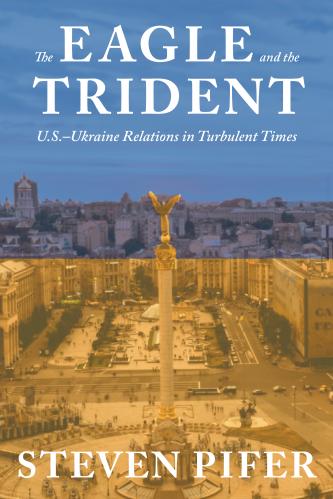

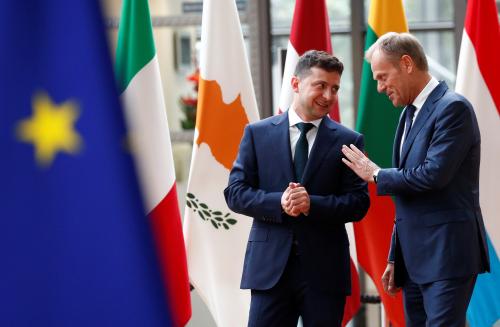
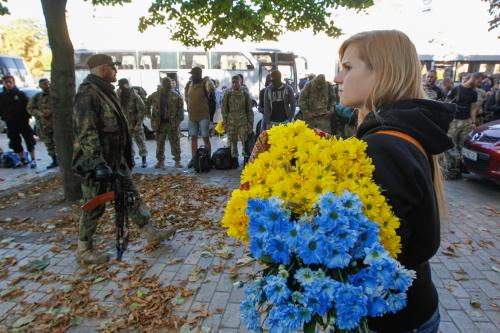
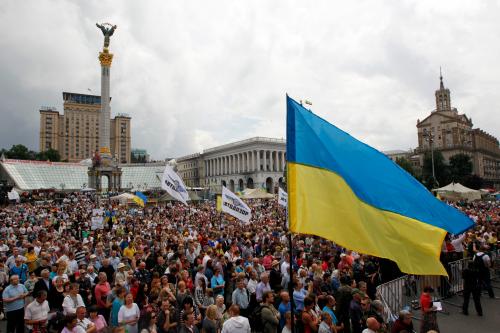
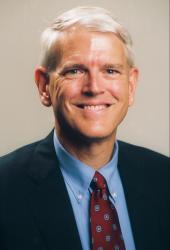

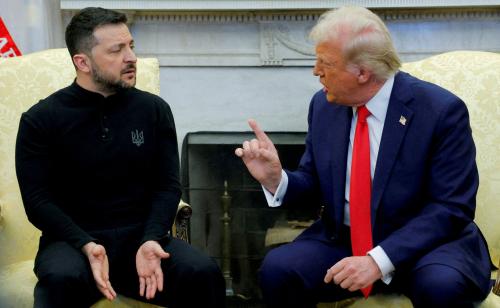
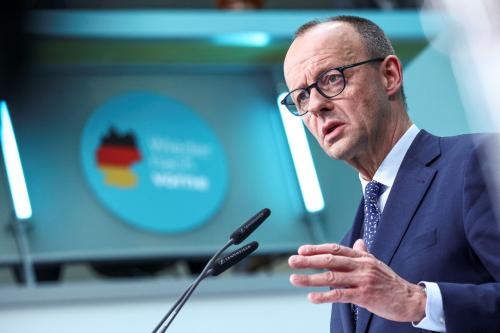
Commentary
How Ukraine views Russia and the West
October 18, 2017